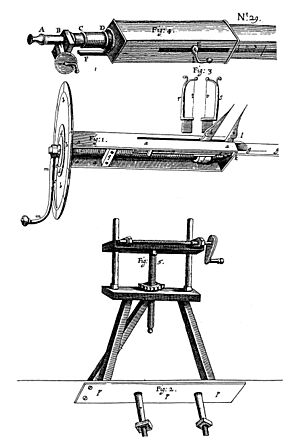William Gascoigne (scientist) facts for kids

William Gascoigne (born 1612 – died 2 July 1644) was a clever English scientist. He was an astronomer, a mathematician, and he made scientific tools. William was from Middleton, a town near Leeds, England. He is famous for inventing two important tools: the micrometer and the telescopic sight. Gascoigne was part of a group of astronomers in northern England. They followed the ideas of Johannes Kepler, a famous astronomer. Other members of this group included Jeremiah Horrocks and William Crabtree.
Contents
Who Was William Gascoigne?
Early Life and Education
William Gascoigne was born in Middleton, Leeds in 1612. His father was Henry Gascoigne, a country gentleman. His mother was Margaret Jane. We don't know much about his early life. He said he studied at the University of Oxford. However, there are no records to prove this.
How He Invented New Tools
In the late 1630s, Gascoigne was working with optical lenses. He was using a special setup based on Johannes Kepler's ideas. One day, a tiny thread from a spider's web got stuck. It landed exactly where the light from the two lenses met.
When Gascoigne looked through his setup, he saw the spider web. It looked bright and very clear. He realized this thread could help him aim his telescope better. This idea led him to invent the telescopic sight. He put crossed wires at the focal point of the lenses. These wires helped define the exact center of what he was looking at.
He then added this new sight to a large sextant. A sextant is a tool used to measure angles. Gascoigne's sextant was five feet wide. It could measure the distance between stars and planets very, very accurately. This was much better than older tools.
Gascoigne then had another brilliant idea. He realized he could add two adjustable points to his tool. He could move these points closer or further apart using a screw. This allowed him to measure the size of an image. By knowing how the screw worked and the lens's focus, he could figure out the actual size of distant objects. This included things like the Moon or other planets. This invention became known as the micrometer. It helped astronomers measure things with amazing accuracy.
Working with Other Astronomers
Gascoigne likely met another astronomer, William Crabtree, around 1640. Crabtree visited Gascoigne's home and saw his new inventions. He was very impressed and understood how important they were.
Crabtree wrote to Gascoigne asking for his own instruments. He also wrote to his friend Jeremiah Horrocks about them. On December 28, 1640, Crabtree wrote to Gascoigne: "My friend Mr. Horrox professeth that little touch which I gave him hath ravished his mind quite from itself and left him in an Exstasie between Admiration and Amazement." This means Horrocks was incredibly excited and amazed by Gascoigne's ideas.
Sadly, Horrocks died before he could use the instruments. But Crabtree and Gascoigne did use them. They tried to prove Horrocks's ideas about the Moon's path around Earth.
The Micrometer's Impact
The micrometer was later improved by Richard Towneley. He was the nephew of Gascoigne's friend, Christopher Towneley. Richard Towneley showed the micrometer to Robert Hooke, another famous scientist. Hooke used it to measure the size of comets and other space objects. The micrometer was a key tool for astronomy for hundreds of years.
The English Civil War and His Death
In 1642, the English Civil War began in England. Gascoigne joined the army of King Charles I. He was in charge of supplies for Yorkshire. William Crabtree lived in an area that supported the other side. Because of the war, Gascoigne and Crabtree could no longer send letters to each other.
William Gascoigne died in battle. He was killed at the Battle of Marston Moor in Yorkshire on July 2, 1644. Charles Towneley, the father of his friend Richard Towneley, also died in the same battle.
What Happened to His Work?
After Gascoigne died, some of his papers and letters were saved. Christopher and Richard Towneley got them. They showed these papers to John Flamsteed. Flamsteed was the first Astronomer Royal of England. He saw Horrocks, Crabtree, and Gascoigne as the founders of British astronomy. He believed they continued the work of Galileo and Kepler.
Flamsteed included five pages of their letters and observations in his huge book, Historia Coelestis Britannica (published in 1725). Many of Gascoigne's papers were lost during the English Civil War. More were lost later in the Great Fire of London. Most of the papers that still exist are kept at the Bodleian Library at the University of Oxford.
Remembering William Gascoigne
In March 2018, the Leeds Civic Trust placed a blue plaque in Leeds to honor Gascoigne. A blue plaque is a special sign that marks important places or people. David Sellers, who wrote a book about Gascoigne, unveiled the plaque. He said: "Although his name is known by astronomers, his role as a pioneer in precision astronomy deserves wider public recognition. I hope that this plaque will help to achieve this and will encourage young people to follow his lead and inspire an interest in the natural world." Local politician Hilary Benn was also there.
Images for kids


